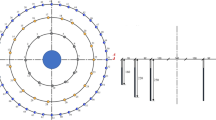Abstract
Based on the character of short-time non-stationary random signal, the relationship between the maximum decking charge and energy distribution of blasting vibration signals was investigated by means of the wavelet packet method. Firstly, the characteristics of wavelet transform and wavelet packet analysis were described. Secondly, the blasting vibration signals were analyzed by wavelet packet based on software MATLAB, and the change of energy distribution curve at different frequency bands were obtained. Finally, the law of energy distribution of blasting vibration signals changing with the maximum decking charge was analyzed. The results show that with the increase of decking charge, the ratio of the energy of high frequency to total energy decreases, the dominant frequency bands of blasting vibration signals tend towards low frequency and blasting vibration does not depend on the maximum decking charge.
Similar content being viewed by others
References
ZHANG Xian-da, BAO Zheng. Non-stationary signal analysis and processing[M]. Beijing: National Defence Industry Press, 1998: 12–14. (in Chinese)
WANG Hong-yu. Non-stationary random signal analysis and processing[M]. Beijing: National Defence Industry Press, 1999: 12–20. (in Chinese)
LING Tong-hua. Blast vibration effect and initiative control of vibrational damage[D]. Changsha: School of Resources and Safety Engineering, Central South University, 2004: 40–60. (in Chinese)
Chui C K. An introduction to wavelets [M]. New York: Academic Press, 1992: 297–333.
LIN Da-chao, SHI Hui-ji, BAI Chun-hua, et al. Time frequency analysis of explosion seismic effects[J]. Explosion and Shock Waves, 2003, 23(1): 31–36. (in Chinese)
LOU Jian-wu, LONG Yuan, XU Quan-jun, et al. A study on the extraction and prediction of blasting seismic wave characteristics by wavelet packets technique [J]. Explosion and Shock Waves, 2004, 24(3): 261–267. (in Chinese)
WEN Jian-bo, ZHOU Jin-xiong, ZHANG Ling. Multiscale adjustment for design earthquake accelerogram by wavelet packet [J]. Journal of Vibration Engineering, 2004, 17(3): 341–343. (in Chinese)
LI Zhao, MA Rui-heng, WANG Wei. Multifractal based on wavelets and its application to processing blasting vibration signal of rock[J]. Journal of PLA University of Science and Technology, 2005, 6(2): 158–161. (in Chinese)
LIU Ling-pu, ZHOU Hong-yu, HE Pai. On Fourier analysis and wavelet analysis[J]. Journal of Harbin University of Science and Technology, 1998, 3(6): 79–83. (in Chinese)
LOU Jian-wu, LONG Yuan, XU Quan-jun. Study on double-scaled rectangle box model of blasting seismic wave’s fractal dimension computation[J]. Journal of Vibration and Shock, 2005, 24(1): 81–84. (in Chinese)
LI Hong-tao, SHU Da-qiang. Influential factors analysis of blasting vibration attenuation law[J]. Engineering Journal of Wuhan University, 2005, 38(1): 79–82.
HE Ling-song. Characters of wavelet and its affection to the result of wavelet transform[J]. Journal of Vibration Engineering, 2000, 13(1): 143–146. (in Chinese)
Daubechies I. The wavelet transform time-frequency localization and signal analysis[J]. IEEE Transactions on Information Theory, 1990, 36(5): 961–1005.
LING Tong-hua, LI Xi-bing. Analysis on energy distributions of millisecond blast vibration signals using the wavelet packet method[J]. Chinese Journal of Rock Mechanics and Engineering, 2005, 24(7): 1117–1122. (in Chinese)
LING Tong-hua, LI Xi-bing. The features of energy distribution for blast vibration signals based on wavelet packet decomposition[J]. Journal of Central South University of Technology, 2005, 12(Suppl 1): 135–140. (in Chinese)
Author information
Authors and Affiliations
Corresponding author
Additional information
Foundation item: Project(2002CB412703) supported by State Key Fundamental Research and Development Program of China; project (50490272) supported by the National Natural Science Foundation of China
Rights and permissions
About this article
Cite this article
Ling, Th., Li, Xb. Influence of maximum decking charge on intensity of blasting vibration. J Cent. South Univ. Technol. 13, 286–289 (2006). https://doi.org/10.1007/s11771-006-0125-2
Received:
Accepted:
Issue Date:
DOI: https://doi.org/10.1007/s11771-006-0125-2




